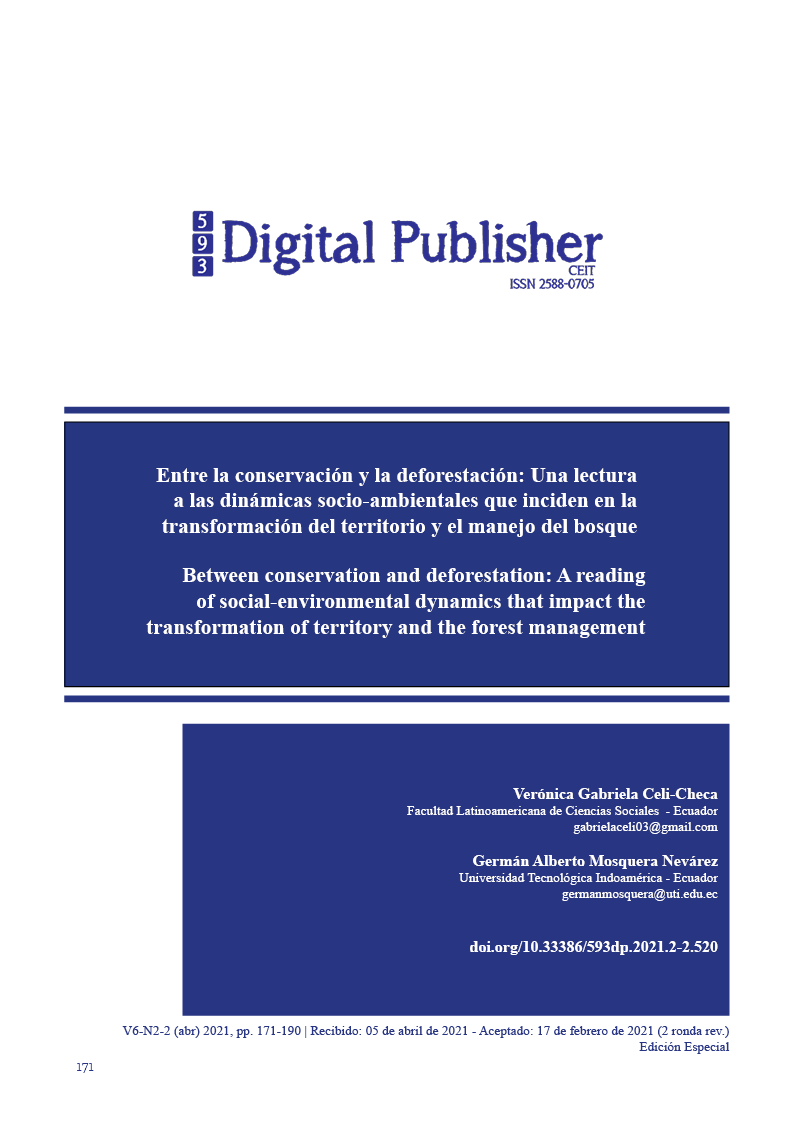Between conservation and deforestation: A reading of social-environmental dynamics that impact the transformation of territory and the forest management
Main Article Content
Abstract
This paper describes, from different theoretical explanations, the patterns and causes of deforestation or forest conservation, considers for this purpose, multidisciplinary frameworks, such as socio-environmental, socio-organizational, political, cultural, economic and institutional approaches. Includes an institutional description, where multi-actor factors intervene in forest dynamics, promoted by civil society, non-governmental organizations, and the State.
Downloads
Article Details

This work is licensed under a Creative Commons Attribution-NonCommercial-ShareAlike 4.0 International License.
1. Derechos de autor
Las obras que se publican en 593 Digital Publisher CEIT están sujetas a los siguientes términos:
1.1. 593 Digital Publisher CEIT, conserva los derechos patrimoniales (copyright) de las obras publicadas, favorece y permite la reutilización de las mismas bajo la licencia Licencia Creative Commons 4.0 de Reconocimiento-NoComercial-CompartirIgual 4.0, por lo cual se pueden copiar, usar, difundir, transmitir y exponer públicamente, siempre que:
1.1.a. Se cite la autoría y fuente original de su publicación (revista, editorial, URL).
1.1.b. No se usen para fines comerciales u onerosos.
1.1.c. Se mencione la existencia y especificaciones de esta licencia de uso.
References
Angelsen Arild y David Kaimowitz. 1999. “Rethinking the Causes of Deforestation: Lessons from Economic Models”. The World Bank Research Observer, 14 (1): 73-98
Asner, Gregory, David Knapp, Paulo Broadbent, Michael Keller, y José Silva. 2005. “Selective logging in the Brazilian Amazon”. Science 310: 480-482.
Basurto, Xavier, y Elinor Ostrom. 2009. “Beyond the Tragedy of the Commons.” Economia delle fonti di energia e dell’ambiente.
Bedoya, Eduardo y Lorien Klein. 1996. “Forty years of political ecology in the Peruvian upper forest: the case of upper Huallaga”. Tropical deforestation: the human dimension, 165-96.
Blaikie, Piers y Harold Brookfield. 1987. Land degradation and society. Londres.
Bravo, Giangiacomo. 2001. “Dai Pascoli ad internet. La teoría delle risorse comuni. Stato e mercato, 21(3), 487-512
Caballero, Gonzalo, Marta Ballesteros y Raquel Fernández-González. 2015. “La economía política de Elinor Ostrom: análisis institucional, comunes y gobernanza policéntrica.” Revista Española de Ciencia Política (38), 13-40.
Casey, Frank, Sara Vickerman, Cheryl Hummon y Bruce Taylor. 2006. Incentives for biodiversity conservation: an ecological and economic assessment. Washington DC. Defenders of Wildlife.
Cuerdo, Miguel y José Luis Ramos Gorostiza. 2000. Economía y naturaleza: una historia de las ideas. Síntesis.
D’Alisa, Giacomo.2013. “Bienes comunes: las estructuras que conectan.” Ecología Política 45: 30-41.
D’Argemir, Dolors Comas.1999. “Ecología política y antropología social”. Areas. Revista Internacional de Ciencias Sociales, (19): 79-99
Durand, Leticia y Elena Lazos. 2004. “Colonization and tropical deforestation in the Sierra Santa Marta, southern Mexico”. Environmental Conservation, 31(01): 11-21.
Durham, William. 1995. “Political Ecology and Environmental Destruction in Latin America”. En Painter, M. y Durham, W.H. (eds.). The Social Causes of Environmental Destruction in Latin America. Ann Arbor, University of Michigan Press. 249-265.
Elgegren, Jorge. 1997. “Instrumentos económicos para la promoción del desarrollo sostenible: posibilidades de aplicación en el Perú.” Perú: la economía de fin de siglo.112-127
En https://mason.gmu.edu/~mpolski/documents/PolskiOstromIAD.pdf
Geist, Helmut J. y Eric F. Lambin. 2002. “Proximate causes and underlying driving forces of tropical deforestation: Tropical forests are disappearing as the result of many pressures, both local and regional, acting in various combinations in different geographical locations”. BioScience 52(2): 143-150
Glassman, Jim. 2006. “Primitive accumulation, accumulation by dispossession, accumulation by ‘extra-economic’means.” Progress in Human Geography 30(5): 608-625
Godoy, Ricardo, Jeffrey Franks, David Wilkie, Mario Alvarado, George Gray-Molina, Raul Roca, Jairo Escobar y Marina Cárdenas. 1996. “The effects of economic development on neotropical deforestation: household and village evidence from Amerindians in Bolivia”. Development discussion papers-Harvard Institute for International Development. doi:10.1.1.539.363&rep=rep1&type=pdf
González-Chavarría, Alexander. 2014. “Análisis institucional multiagente: el problema de estructuración y agencia en la explicación de la emergencia de estructuras de gobernanza”. Revista de Estudios Sociales, (49), 190-204. http://dx.doi.org/10.7440/res49.2014.14
Gutiérrez, Ana Lucía y Flavio Mora. 2011. “El grito de los Bienes Comunes: ¿qué son? y ¿qué nos aportan?.” Revista de ciencias sociales (131-132): 127-145. ISSN: 0482-5276. Disponible en:<http://www.redalyc.org/articulo.oa?id=15323166009> , el 23 de noviembre de 2016
Hardin, Garret. 2009. “The Tragedy of the Commons”. Journal of Natural Resources Policy Research, 1(3): 243-253.
Helfrich, Silke. 2008. “Commons: ámbitos o bienes comunes, procomún o ‘lo nuestro’.” S. Helfrich (comp.). Genes, bytes y emisiones: bienes comunes y ciudadanía. México. Ediciones Böll: 42-48.
Hotelling, Harold. 1931. “The economics of exhaustible resources.” Journal of political Economy 39(2) 137-175.
Lambin, Erick, Helmut Geist y Erika Lepers. 2003. “Dynamics of land-use and land-cover change in tropical regions”. Annual review of environment and resources, 28(1): 205-241.
Lara, Angel. 2002. “El gobierno de los bienes comunes: La evolución de las instituciones de acción colectiva”. Región y sociedad, 14(24): 263-269.
Leff, Enrique. 1998. “La capitalización de la naturaleza y las estrategias fatales del crecimiento insostenible.” Red Latino Americana y Caribeña de Ecología Social, Documentos, disponible en: http://ambiental. net/biblioteca/LeffCapitalizacionNaturaleza. htm
Leff, Enrique. 2001. “Justicia Ambiental. Construcción y Defensa de los Nuevos Derechos Ambientales, Culturales y Colectivos en América Latina”, PNUMA/CEIICH-UNAM, México.
Lizcano, Diego y Alfonso Malky. 2015. “Efecto de la complejidad institucional sobre la deforestación en la Amazonía Colombiana”. Conservation Strategy Fund. Conservación Estratégica Serie Técnica 39. Lima-Perú ISBN 978-612-46952-6-1. http://conservation-strategy.org/sites/default/files/fieldfile/Efecto_Complejidad_institucional_Diego_Lizcano_alta.pdf
Londres: Macmillan Press.
Mäki, Sanna, Risto Kalliola, y Kai Vuorinen. 2001. “Road construction in the Peruvian Amazon: process, causes and consequences”. Environmental Conservation, 28(03): 199-214.
Martínez Alier, Joan. 2015. Ecología política del extractivismo y justicia socio-ambiental. Interdisciplina 3 (7): 57-73.
Martino, Diego. 2007. “Deforestación en la Amazonía: principales factores de presión y perspectivas”. Revista del sur 169 (1):3-20.
Morán, Emilio. 1984. Colonization in the Transamazon and Rondonia. University of Florida Press: Gainesville, FL, USA : 285-303.
Moreno-Sánchez, Rocío del Pilar. 2012. Incentivos Económicos para la Conservación. Un Marco Conceptual. Unidad de Apoyo de la Iniciativa para la Conservación en la Amazonía Andina (ICAA). USAID. Lima.
Ostrom, Elinor y Toh-Kyeong Ahn. 2003. “Una perspectiva del capital social desde las ciencias sociales: capital social y acción colectiva.” Revista mexicana de sociología 65(1): 155-233.
Ostrom, Elinor, Roy Gardner y James Walker. 1994. Rules, games, and common-pool resources. University of Michigan Press.
Ostrom, Elinor. 1990. “Governing the commons: The evolution of institutions for collective action.” Camdridge University Press, Cambridge.
Ostrom, Elinor. 2000. El gobierno de los bienes comunes. La evolución de las instituciones colectivas. México. UNAM/CRIM/FCE. ISBN 968–16–6343–8: 395
Ostrom, Elinor. 2009. “A general framework for analyzing sustainability of social-ecological systems”. Science, 325(5939): 419-422.
Panayotu, Theodore. 1994. Economic instruments for environmental management and sustainable development. Programa de Naciones Unidas para el Ambiente (UNEP), Unidad de Ambiente y Economía.
Perz, Stephen. 2002. “The changing social contexts of deforestation in the Brazilian Amazon”. Revista Social Science Quarterly, 83(1): 35-52.
Polski, Margaret y Elinor Ostrom. 1999. “An Institutional Framework for Policy Analysis and Design.” Workshop in political theory and policy analysis working paper W98-27. Universidad de Indiana, Bloomington.
Rhoades, Robert E. y Jody Stallings. 2003. “La conservación y el desarrollo integrado: lecciones aprendidas al vincular pueblos, proyectos y políticas en América tropical”. Editorial Abya Yala.
Rudel, Thomas K. y Bruce Horowitz. 1993. Tropical Deforestation: Small Farmers and Land Clearing in the Ecudorian Amazon. Columbia University Press.
Rudel, Thomas K., Diane Bates y Rafael Machinguiashi. 2002. “Ecologically Noble Amerindians? Cattle Ranching and Cash Cropping among Shuar and Colonists in Ecuador”. Latin American Research Review. 37 (1): 144-159.
Sánchez, David. 2009. “Recreaciones, cuidados, entornos y espacios locales para la humanidad: en torno a lo común y lo público en perspectiva de derechos humanos.” Políticas públicas ambientales. http://pensamientocritico.info/articulos/otros-autores/214-recreacionescuidados-entornos-y-espacios-localespara- la-humanidad-en-torno-a-locomun-y-lo-publico-en-perspectiva-dederechos-humanos.html
Schmink, Marianne y Charles Wood. 1987. “The Political Ecology of Amazonia”. Lands at risk in the Third World: Local-level perspectives, 38-57.
Vatn, Arild. 2005. Institutions and the Environment. Gran Bretaña,MPG Books.ISBN:1 84376 100 9.
Wunder, Sven. 2000. The economics of deforestation: the example of Ecuador.
Wunder, Sven. 2005. Payments for environmental services: some nuts and bolts. CIFOR Occasional Paper 42: 24.
Zambrano, Angélica, Eben N. Broadbent, Marianne Schmink, Stephen G. Perz, Gregory P. Asner. 2010. “Deforestation drivers in southwest Amazonia: comparing smallholder farmers in Iñapari, Peru, and Assis Brasil”. Conservation and Society, Brasil 8(3): 157-170.



